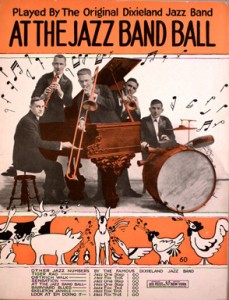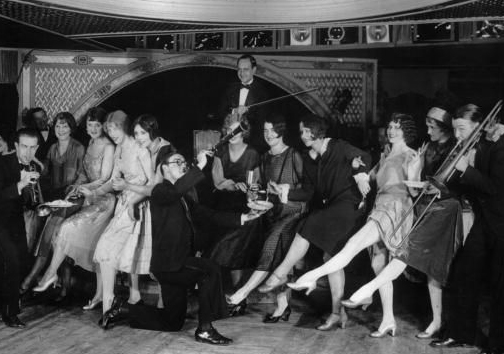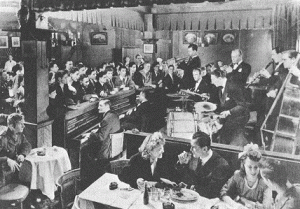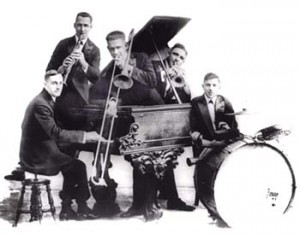What sets early jazz apart from other 20th century styles, such as 1930s' 'Swing' or 'Bebop' from the 40s and 50s?
Early jazz was dance music. Crowded, noisy, and smoky dance halls in New Orleans, Chicago and San Francisco's Barbary Coast served as venues where jazz first found its voice in the years after World War I. 'Jazz' (originally spelled 'jass') was coined to describe the insistent, relentlessly peppy rhythmic quality of this seemingly ragtime-based music coming out of New Orleans. Back then (as now), 'jazz' was often used interchangeably with 'enthusiasm.'
From our 21st-century perspective it's important to remember that in the 1920s, the self-conscious, wondrously abstract 'Bebop' of the 1950s, with its much smaller audience of sophisticated 'hipsters,' and upon which a great deal of contemporary jazz is based, lay far in the future. But in its early 20th-century genesis, jazz appealed to a mass audience, and accessibility was key. Since all styles and approaches to jazz which evolved in its near 100-year history are played today, stylistic differences stand out in stark contrast.
One of the most important differences—and a defining characteristic of early jazz—is the jazz ensemble chorus, where all the horns improvise, together, at the same time. These boisterous, spirited choruses are often referred to as 'collective improvisation.' Another term used by musicians is 'polyphony' (many sounds or voices).
During a jazz ensemble chorus performance the roles the horns play are well-defined and natural for each. The declamatory cornet (or trumpet), explicitly states the melody (or 'lead') in a 'jazzed-up' form, embellished with hot or syncopated rhythm. The highly mobile clarinet 'fills in' with a detailed, constantly moving filigree of notes outlining the harmony, or chord changes, of the underlying tune.
The trombone, with its lower register and rather primitive and cumbersome slide mechanism, plays a much simpler part based on the bass notes and counter-melodies of the tune. The slide enables the player to 'smear' from one note to another, creating the familiar 'tailgate' trombone effect—so named, according to legend, because of the placement of the trombone at the 'tailgate' of wagons used to promote bands in the streets of New Orleans.
The noisy jazz ensembles as played by early bands projected an element of chaos and rebellion that appealed to the young. By strictly adhering to the tonality of the tune and playing within the 'rules' of the jazz ensemble for each instrument, audiences could easily recognize the melody of each tune. Further, bands invented their own unique additions and embellishments, based on easily-perceived 'riff' melodies and hot rhythms; an important part of the jazz language.

"At the Jazz Band Ball" sheet music, 1928. Image courtesy Johns Hopkins University, Levy Sheet Music Collection.
The first of the New Orleans bands to catch on nationally was the Original Dixie Jass Band, now referred to as the Original Dixieland Jazz Band or ODJB. The ODJB members composed a series of tunes they recorded in 1917 to follow up on the success of their first mega-hit, "Livery Stable Blues." Some of these tunes, such as "Dixie Jass Band One-Step," "Fidgety Feet" and "At the Jazz Band Ball" were re-recorded many times through the ensuing decades by enormously popular bands such as; Bix Beiderbecke and The Wolverine Orchestra, Fletcher Henderson, The Bob Crosby Bob Cats, Bud Freeman's Summa Cum Laude, and Eddie Condon. These tunes are considered a core component of Traditional Jazz.
This week on Riverwalk Jazz The Jim Cullum Jazz Band plays it 'hotter than hot' on a collection of jazz classics from New Orleans and beyond. It's a summer concert of tunes hot off the grill—live from the Stanford Jazz Workshop with Evan Christopher on clarinet. The Jim Cullum Jazz Band brings a fresh approach to its classic repertoire in nightly performances at The Landing in San Antonio and on our show this week. Included in this mix of old and new is a Cullum original tune, "Enchilada Man."

Evan Christopher. Photo courtesy of the artist.
New Orleans-based clarinetist Evan Christopher, heard on this week's broadcast, held The Jim Cullum Jazz Band clarinet chair from 1996 through 1999. Evan has a deep commitment to exploring the full range of musical possibilities in the traditions of New Orleans Jazz. His sound is anchored in the musical language created by early Creole clarinetists Sidney Bechet, Omer Simeon and Barney Bigard.
Evan maintains his busy schedule of concerts both domestic and abroad with his groups, the Jazz Traditions Project and Django à la Créole. Publishing his research and academic presentations on the New Orleans clarinet style led to Evan's pursuit of a master's degree in Musicology at Tulane University.
Photo credit for Home Page: Clarinetist Evan Christopher. Photo courtesy the artist.
Text based on Riverwalk Jazz script by Margaret Moos Pick ©2012




